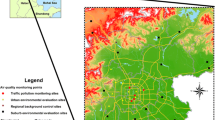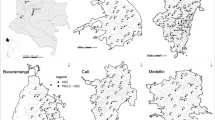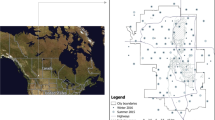Abstract
Air quality information is not captured adequately due to limited numbers of air quality monitoring stations across many cities worldwide. Limited studies apply advanced spatial map** techniques to predict pollutant concentrations in highly polluted regions with high spatial variability. This paper demonstrates an advanced detrending spatial map** technique to assess the variations of particulate matter concentrations across different land use categories in a highly polluted city—Delhi—and estimate population-weighted average concentrations in the city. The “Detrended Kriging” method uses the city’s monitored datasets and land use information to predict pollutant concentrations. Concentrations are detrended based on high-resolution local land use characteristics and then interpolated using ordinary kriging before retrending again. The model estimates population-weighted concentrations (more important for health exposures) of PM2.5 (113 µg/m3) and PM10 (248 µg/m3) for Delhi and finds them to be 21–36% higher than the monitored values in the crucial winter season of 2018. The model demonstrates satisfactory performance on both spatial and temporal scales in Delhi and shows high index of agreement (d = 0.86 for PM10 and 0.81 for PM2.5), low RMSE (27.3 µg/m3 for PM10 and 11.8 µg/m3 for PM2.5), and low bias (− 1.6 µg/m3 for PM10 and − 0.5 µg/m3 for PM2.5) for the detrended kriging model, in comparison to ordinary kriging (PM2.5 (d = 0.54, RMSE = 13.81, bias = − 0.86) and PM10 (d = 0.33, RMSE = 41.73, bias = − 4.7)) and inverse distance weighting method (PM2.5 (d = 0.65, RMSE = 16.08, bias = 2.93) and PM10 (d = 0.55, RMSE = 46.10, bias = 7.8)). Statistical measure “d” varies between 0 (no agreement) and 1 (perfect match).
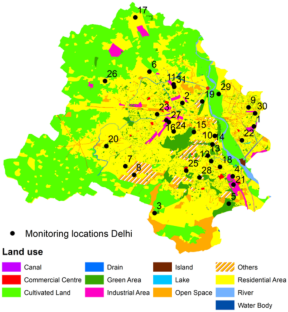
Source: Land-use data was developed through Copernicus Global Land Cover Layers: CGLS-LC100 for 2011 using Landsat Copernicus satellite



Source: cpcb.nic.in
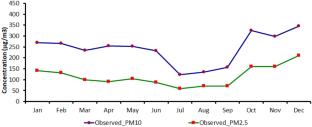





Similar content being viewed by others
Availability of Data and Material
Dataset used as input is available on the public domain https://app.cpcbccr.com/ccr/#/caaqm-dashboard-all/caaqm-landing/data. The datasets generated during and/or analyzed during the current study are available from the corresponding author on request.
Code Availability
The code/software generated during the current study is available from the corresponding author on reasonable request.
References
Brauer, M., Amann, M., Burnett, R. T., Cohen, A., Dentener, F., Ezzati, M., Henderson, S. B., Krzyzanowski, M., Martin, R. V., Van Dingenen, R., & Van Donkelaar, A. (2012). Exposure assessment for estimation of the global burden of disease attributable to outdoor air pollution. Environmental science & technology, 46(2), 652–660.
Pandey, A., Brauer, M., Cropper, M. L., Balakrishnan, K., Mathur, P., Dey, S., & Dandona, L. (2021). Health and economic impact of air pollution in the states of India: The Global Burden of Disease Study 2019. The Lancet Planetary Health, 5(1), e25–e38.
Cheng, Z., Li, L., & Liu, J. (2017). Identifying the spatial effects and driving factors of urban PM2. 5 pollution in China. Ecological Indicators, 82, 61–75.
Mensink, C., Deutsch, F., Janssen, L., Torfs, R., & Vankerkom, J. (2006). Comprehensive modelling of PM 10 and PM 2.5 scenarios for Belgium and Europe in 2010. In International Conference on Numerical Methods and Applications (pp. 466–474). Springer, Berlin, Heidelberg.
Tombette, M., & Sportisse, B. (2007). Aerosol modeling at a regional scale: Model-to-data comparison and sensitivity analysis over Greater Paris. Atmospheric Environment, 41(33), 6941–6950.
Vautard, R., Builtjes, P. H., Thunis, P., Cuvelier, C., Bedogni, M., Bessagnet, B., Honore, C., Moussiopoulos, N., Pirovano, G., Schaap, M., & Stern, R. (2007). Evaluation and intercomparison of Ozone and PM10 simulations by several chemistry transport models over four European cities within the CityDelta project. Atmospheric Environment, 41(1), 173–188.
Brauer, M., Guttikunda, S. K., Nishad, K. A., Dey, S., Tripathi, S. N., Weagle, C., & Martin, R. V. (2019). Examination of monitoring approaches for ambient air pollution: A case study for India. Atmospheric Environment, 216, 116940.
Sharma, S., Chatani, S., Mahtta, R., Goel, A., & Kumar, A. (2016). Sensitivity analysis of ground level ozone in India using WRF-CMAQ models. Atmospheric environment, 131, 29–40.
Singh, N., Agarwal, S., Sharma, S., Chatani, S., & Ramanathan, V. (2021). Air pollution over India: Causal factors for the high pollution with implications for mitigation. ACS Earth and Space Chemistry, 5(12), 3297–3312.
Van Aardenne, J. A. (2002). Uncertainties in emission inventories. Thesis Wageningen University. https://edepot.wur.nl/198412
Ahangar, F. E., Freedman, F. R., & Venkatram, A. (2019). Using low-cost air quality sensor networks to improve the spatial and temporal resolution of concentration maps. International Journal of Environmental Research and Public Health, 16(7), 1252. Published 8 Apr 2019. https://doi.org/10.3390/ijerph16071252
Hooyberghs, J., Mensink, C., Dumont, G., & Fierens, F. (2006). Spatial interpolation of ambient ozone concentrations from sparse monitoring points in Belgium. Journal of Environmental Monitoring, 8(11), 1129–1135.
Janssen, S., Dumont, G., Fierens, F., & Mensink, C. (2008). Spatial interpolation of air pollution measurements using CORINE land cover data. Atmospheric Environment, 42(20), 4884–4903.
Arain, M. A., Blair, R., Finkelstein, N., Brook, J. R., Sahsuvaroglu, T., Beckerman, B., Zhang, L., & Jerrett, M. (2007). The use of wind fields in a land use regression model to predict air pollution concentrations for health exposure studies. Atmospheric Environment, 41(16), 3453–3464.
Denby, B., Horálek, J., Walker, S. E., Eben, K., & Fiala, J. (2005). Interpolation and assimilation methods for European scale air quality assessment and map**. Part I: Review and Recommendations. European Topic Centre on Air and Climate Change Technical Paper, 7.
Ross, Z., Jerrett, M., Ito, K., Tempalski, B., & Thurston, G. D. (2007). A land use regression for predicting fine particulate matter concentrations in the New York City region. Atmospheric Environment, 41(11), 2255–2269.
Brauer, M., Hoek, G., van Vliet, P., Meliefste, K., Fischer, P., Gehring, U., Heinrich, J., Cyrys, J., Bellander, T., Lewne, M., & Brunekreef, B. (2003). Estimating long-term average particulate air pollution concentrations: Application of traffic indicators and geographic information systems. Epidemiology, pp. 228–239.
Henderson, S. B., Beckerman, B., Jerrett, M., & Brauer, M. (2007). Application of land use regression to estimate long-term concentrations of traffic-related nitrogen oxides and fine particulate matter. Environmental Science & Technology, 41(7), 2422–2428.
Jha, D. K., Sabesan, M., Das, A., Vinithkumar, N. V., & Kirubagaran, R. (2011). Evaluation of interpolation technique for air quality parameters in Port Blair, India. Universal Journal of Environmental Research & Technology, 1(3).
Shukla, K., Kumar, P., Mann, G. S., & Khare, M. (2020). Map** spatial distribution of particulate matter using kriging and inverse distance weighting at supersites of megacity Delhi. Sustainable Cities and Society, 54, 101997.
WHO. (2018). WHO Global Ambient Air Quality Database (p. 2018). World Health Organization.
GBD [Global Burden of Diseases]. (2018). MAPS Working Group. Burden of disease attributable to major air pollution sources in India. Special Report, 21. HEI.
CPCB. (2017). CPCB website, Central Pollution Control Board. https://app.cpcbccr.com/ Accessed on Mar 2018.
TERI, & ARAI. (2018). Source apportionment of PM2.5 & PM10 of Delhi NCR. The Energy and Resources Institute, New Delhi and Automotive Research Association of India, Pune. Available at https://www.teriin.org/sites/default/files/2018-08/Report_SA_AQM-Delhi-NCR_0.pdf
Isaaks, E. H., & Srivastava, R. M. (1989). An introduction to applied geostatistics. Oxford University Press.
Willmott, C. J. (1981). On the validation of models. Physical Geography, 2, 184e194.
Sembhi, H., Wooster, M. J., Zhang, T., Sharma, S., Singh, N., Agarwal, S., Boesch, H., Gupta, S., Misra, A., Tripathi, S. N., & Mor, S. (2020). Post-monsoon air quality degradation across Northern India: assessing the impact of policy-related shifts in timing and amount of crop residue burnt. Environmental Research Letters.
Hama, S. M., Kumar, P., Harrison, R. M., Bloss, W. J., Khare, M., Mishra, S., Namdeo, A., Sokhi, R., Goodman, P., & Sharma, C. (2020). Four-year assessment of ambient particulate matter and trace gases in the Delhi-NCR region of India. Sustainable Cities and Society, 54, 102003.
Van Loon, M., Vautard, R., Schaap, M., Bergstrom, R., Bessagnet, B., Brandt, J., Builtjes, P. J. H., Christensen, J. H., Cuvelier, C., Graff, A., Jonson, J. E., Krol, M., Langner, J., Roberts, P., Rouil, L., Stern, R., Tarrason, L., Thunis, P., Vignati, E., & Wind, P. (2007). Evaluation of long- term ozone simulations from seven regional air quality models and their ensemble. Atmospheric Environment, 41, 2083–2097.
CPCB. (2014). National Air Quality Index. , Central Pollution Control Board, New Delhi, URL: http://www.indiaenvironmentportal.org.in/files/file/Air%20Quality%20Index.pdf
Agarwal, S., Sharma, S., Suresh, R., Rahman, M. H., Vranckx, S., Maiheu, B., Blyth, L., Gargava, P, Shukla, V. K., & Batra, S. (2020). Air quality forecasting using artificial neural networks with real time dynamic error correction in highly polluted regions. Science of The Total Environment, 139454.
Acknowledgements
We want to thank Dr. Arindam Dutta for hel** prepare charts for Fig. 5. We would also like to thank Dr. Prateek Sharma, Professor TERI SAS, for his guidance on statistical analysis.
Funding
We want to acknowledge and thank the Central Pollution Control Board of India for providing funding support for this work under the EPC grants 201713263.
Author information
Authors and Affiliations
Contributions
Conceptualization: Sumit Sharma, Lisa Blyth, Stijn Janssen. Methodology, software: Stijn Vranckx, Bino Maiheu, Writing: Md. H. Rehman, Shivang Agarwal, Sumit Sharma. Data handling: Sousa Jorge, R Suresh, Md. H. Rehman, Shivang Agarwal, V K Shukla, Sakshi Batra. Supervision: Sumit Sharma. Writing—reviewing and editing: Prashant Gargava, Stijn Janssen.
Corresponding author
Ethics declarations
Ethics Approval
The authors declare no ethical violation during the preparation of this manuscript.
Consent to Participate
The authors give approve participation in this journal.
Consent for Publication
The author approves publication in this journal.
Conflict of Interest
The authors declare no competing interests.
Additional information
Publisher's Note
Springer Nature remains neutral with regard to jurisdictional claims in published maps and institutional affiliations.
Supplementary Information
Below is the link to the electronic supplementary material.
Rights and permissions
About this article
Cite this article
Rahman, M.H., Agarwal, S., Sharma, S. et al. High-Resolution Map** of Air Pollution in Delhi Using Detrended Kriging Model. Environ Model Assess 28, 39–54 (2023). https://doi.org/10.1007/s10666-022-09842-5
Received:
Accepted:
Published:
Issue Date:
DOI: https://doi.org/10.1007/s10666-022-09842-5


